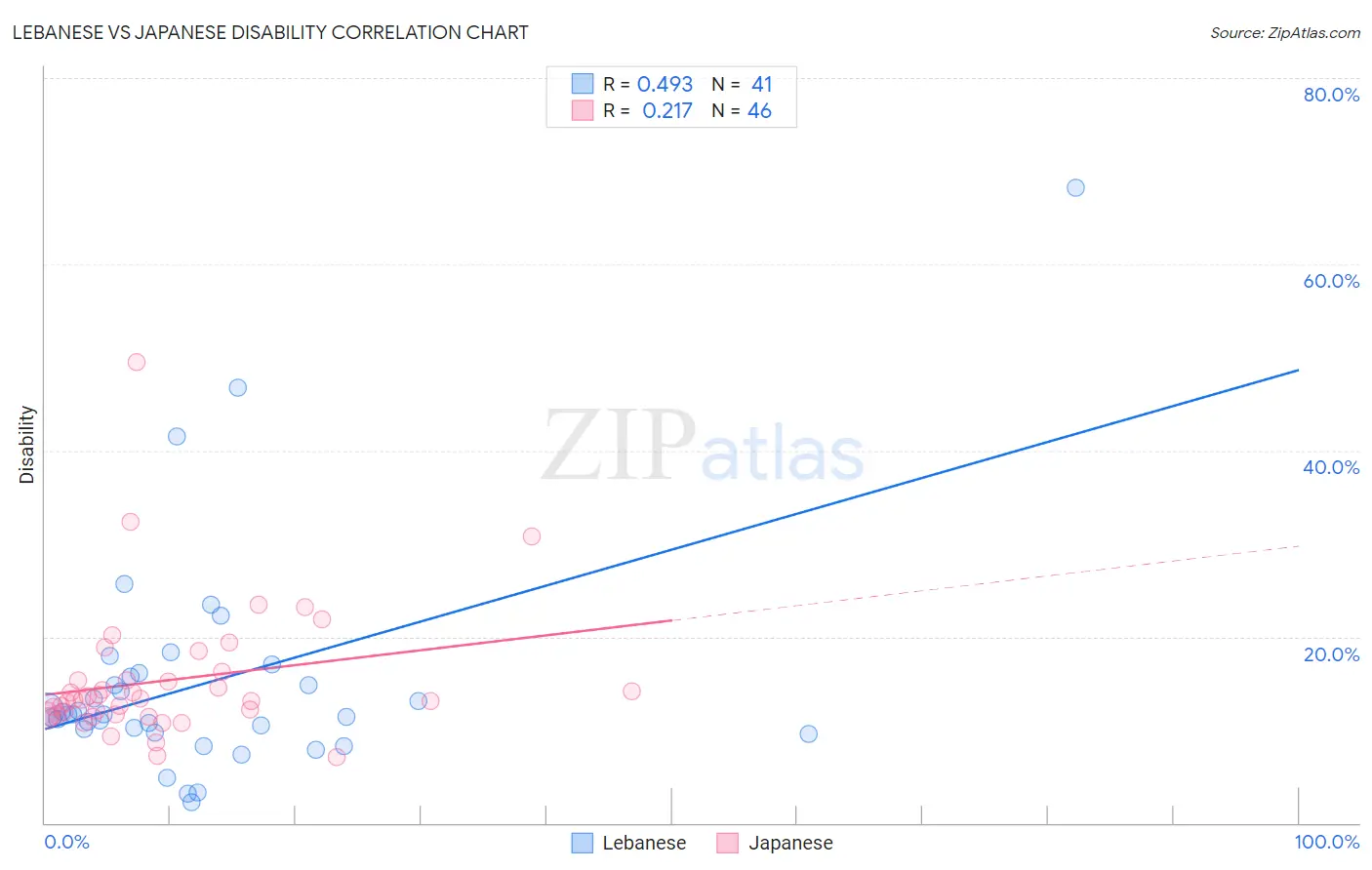Lebanese vs Japanese Disability
COMPARE
Lebanese
Japanese
Disability
Disability Comparison
Lebanese
Japanese
11.8%
DISABILITY
27.9/ 100
METRIC RATING
187th/ 347
METRIC RANK
12.2%
DISABILITY
2.3/ 100
METRIC RATING
234th/ 347
METRIC RANK
Lebanese vs Japanese Disability Correlation Chart
The statistical analysis conducted on geographies consisting of 401,592,225 people shows a moderate positive correlation between the proportion of Lebanese and percentage of population with a disability in the United States with a correlation coefficient (R) of 0.493 and weighted average of 11.8%. Similarly, the statistical analysis conducted on geographies consisting of 249,165,535 people shows a weak positive correlation between the proportion of Japanese and percentage of population with a disability in the United States with a correlation coefficient (R) of 0.217 and weighted average of 12.2%, a difference of 3.1%.

Disability Correlation Summary
| Measurement | Lebanese | Japanese |
| Minimum | 2.2% | 7.1% |
| Maximum | 68.2% | 49.5% |
| Range | 66.0% | 42.4% |
| Mean | 15.0% | 15.3% |
| Median | 11.6% | 13.2% |
| Interquartile 25% (IQ1) | 9.9% | 11.6% |
| Interquartile 75% (IQ3) | 16.0% | 15.3% |
| Interquartile Range (IQR) | 6.0% | 3.8% |
| Standard Deviation (Sample) | 12.1% | 7.3% |
| Standard Deviation (Population) | 11.9% | 7.2% |
Similar Demographics by Disability
Demographics Similar to Lebanese by Disability
In terms of disability, the demographic groups most similar to Lebanese are Immigrants from Scotland (11.8%, a difference of 0.020%), Immigrants from Burma/Myanmar (11.8%, a difference of 0.030%), Iraqi (11.8%, a difference of 0.11%), Honduran (11.8%, a difference of 0.18%), and Immigrants from Mexico (11.9%, a difference of 0.24%).
| Demographics | Rating | Rank | Disability |
| Immigrants | Honduras | 37.8 /100 | #180 | Fair 11.8% |
| Immigrants | Oceania | 34.3 /100 | #181 | Fair 11.8% |
| Icelanders | 34.0 /100 | #182 | Fair 11.8% |
| Hondurans | 31.2 /100 | #183 | Fair 11.8% |
| Iraqis | 30.0 /100 | #184 | Fair 11.8% |
| Immigrants | Burma/Myanmar | 28.5 /100 | #185 | Fair 11.8% |
| Immigrants | Scotland | 28.2 /100 | #186 | Fair 11.8% |
| Lebanese | 27.9 /100 | #187 | Fair 11.8% |
| Immigrants | Mexico | 23.8 /100 | #188 | Fair 11.9% |
| Immigrants | Zaire | 21.8 /100 | #189 | Fair 11.9% |
| Immigrants | West Indies | 21.1 /100 | #190 | Fair 11.9% |
| Ute | 19.5 /100 | #191 | Poor 11.9% |
| Lithuanians | 18.8 /100 | #192 | Poor 11.9% |
| Immigrants | Bosnia and Herzegovina | 18.0 /100 | #193 | Poor 11.9% |
| Somalis | 17.3 /100 | #194 | Poor 11.9% |
Demographics Similar to Japanese by Disability
In terms of disability, the demographic groups most similar to Japanese are Bahamian (12.2%, a difference of 0.030%), Yup'ik (12.2%, a difference of 0.040%), Italian (12.2%, a difference of 0.12%), Malaysian (12.2%, a difference of 0.13%), and Chinese (12.2%, a difference of 0.13%).
| Demographics | Rating | Rank | Disability |
| Alsatians | 3.3 /100 | #227 | Tragic 12.1% |
| West Indians | 2.9 /100 | #228 | Tragic 12.2% |
| Inupiat | 2.8 /100 | #229 | Tragic 12.2% |
| Samoans | 2.6 /100 | #230 | Tragic 12.2% |
| Malaysians | 2.5 /100 | #231 | Tragic 12.2% |
| Italians | 2.5 /100 | #232 | Tragic 12.2% |
| Bahamians | 2.3 /100 | #233 | Tragic 12.2% |
| Japanese | 2.3 /100 | #234 | Tragic 12.2% |
| Yup'ik | 2.2 /100 | #235 | Tragic 12.2% |
| Chinese | 2.0 /100 | #236 | Tragic 12.2% |
| Immigrants | Congo | 1.9 /100 | #237 | Tragic 12.2% |
| Norwegians | 1.9 /100 | #238 | Tragic 12.2% |
| Swedes | 1.8 /100 | #239 | Tragic 12.2% |
| Hungarians | 1.7 /100 | #240 | Tragic 12.2% |
| Yugoslavians | 1.7 /100 | #241 | Tragic 12.2% |